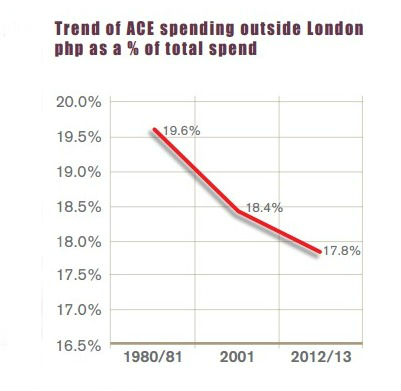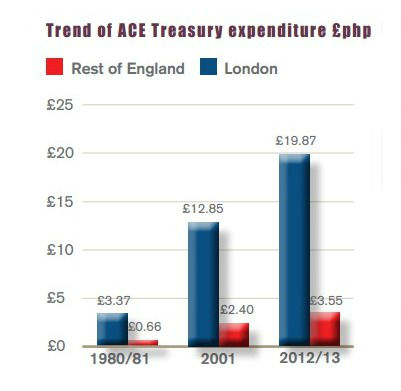Correcting the London bias: £600m should be taken from capital and given to regions, says new report

Up to £600 million of arts funding should be diverted from London to the regions to compensate for a long-standing Arts Council England (ACE) bias towards the capital. That’s the recommendation of a new report, published this week, that is certain to fuel more funding controversy ahead of further expected cuts in the new year.
According to Rebalancing Our Cultural Capital: A contribution to the debate on national policy for the arts and culture in England, 75% of available ACE funding is being awarded to London, a far higher proportion than is allocated to capital cities in other European countries. In addition, of the £450 million doled out in 2012/13 by the Department of Culture, Media and Sport (DCMS) direct to 16 major ‘national’ cultural organisations, such as the National Theatre, 90% was concentrated on London.
The combined impact of these two sources means that each Londoner benefits to the tune of £68.99 per year in arts funding, compared to just £4.58 per head in the rest of England.
London’s not-for-profit arts organisations also benefit in three other key ways: London’s local government still retains a substantial cultural budget; the city has the West End, a substantial commercial cultural sector, drawing in national and international audiences that have a knock-on effect to the subsidised sector; and London-based organisations attract the lion’s share (82%) of corporate and philanthropic giving for the arts.
The reality is precarious
In response to the report, Tom Morris, artistic director at regional powerhouse Bristol Old Vic, commented: “This is a brilliantly argued report, and it’s essential to see it in context. Regional theatres have been in receipt of a triple whammy. First of all, our core funding was cut in the austerity measure. Secondly, across the country, local authorities have reduced their investment in the arts, although thankfully in Bristol it’s been at least kept steady. And thirdly, as we all know, the philanthropic and sponsorship income that we’ve been encouraged to raise is far harder to attain in the regions than it is in London.

“What that means is that in any regional theatre … we’re absolutely in the margins of viability. We’re looking day by day at whether or not we can afford to create next year’s programme, and that’s because of that triple whammy. The reality is precarious.”
Invest £600m in new non-London fund
To add insult to injury, according to the report, despite the plethora of cultural opportunities on their doorstep, Londoners do not engage with the arts any more than those outside the capital – in fact, their response is below the national average.
The report’s authors – Peter Stark, Christopher Gordon and David Powell – advocate redressing the balance by reducing London’s overall share of public arts funds by 10% (which would still be seven times the level of funding per head of population in the rest of England). This saving should be used to create a new National Investment Programme of £600 million over the five years of a parliament, “specifically charged with investment in new cultural production outside London”.
“I don’t think that’s necessary,” to take money away from London and give it to regions, said Tom Morris, who prior to Bristol, held posts as an associated director at the National Theatre (where he co-directed War Horse) and artistic director at south London’s Battersea Arts Centre. “We all know that London requires investment, and we all know that London is a fantastic ferment of cultural activity and has huge benefit to the country through its successes.
“What I would recommend is the identification of a strategic fund of lottery money, which is set aside specifically to invest in the creative sector in the regions. Additional funding coming from the lottery money, which already exists, could be deployed by the Arts Council to first of all secure the future, and secondly, invest in the future of our regional arts institutions, which are now in the margins of viability.”
To watch the full video response from Tom Morris, click here.










